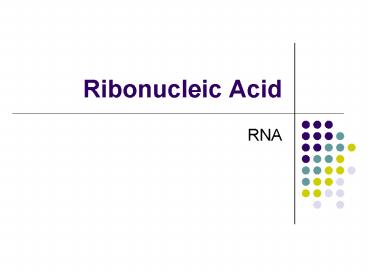Ribonucleic Acid - PowerPoint PPT Presentation
Title:
Ribonucleic Acid
Description:
Ribonucleic Acid RNA The structure of ribonucleic acid Learning Objectives: Describe the structure of ribonucleic acid (RNA) Describe the structure and role of ... – PowerPoint PPT presentation
Number of Views:115
Avg rating:3.0/5.0
Title: Ribonucleic Acid
1
Ribonucleic Acid
- RNA
2
The structure of ribonucleic acid
- Learning Objectives
- Describe the structure of ribonucleic acid (RNA)
- Describe the structure and role of messenger RNA
(mRNA) - Describe the structure and role of transfer RNA
(tRNA) - Describe the structure and role of ribosomal RNA
(rRNA)
3
RNA
- RNA ribonucleic acid
- RNA is a single -stranded polymer
- Each RNA nucleotide consists of
- A pentose sugar (ribose)
- A phosphate group
- A base adenine, cytosine, guanine, uracil
(instead of thymine) - RNA used in protein synthesis is messenger RNA
(mRNA) or transfer RNA (tRNA).
4
RNA contains the pentose sugar ribose. DNA
contains the pentose sugar deoxyribose.
RNA
DNA
5
The Genetic Code (recap)
- 3 nucleotide bases on mRNA (a codon) codes for
each amino acid in a protein (DNA triplet
code). - A few amino acids have a single codon.
- The code is degenerate most amino acids have
more than one codon. - 3 codons code for no amino acids they are stop
codons and mark the end of the polypeptide chain. - Non-overlapping each nucleotide is read only
once. - Universal same codon codes for the same amino
acid in all organisms (few minor exceptions).
6
mRNA (m messenger)
7
- tRNA (t transfer)
Amino acid joins here
Anticodon
8
- Complete the worksheet
- DNA RNA Comparison
9
Messenger RNA (mRNA)
- Used to transfer the DNA code from the nucleus to
the cytoplasm, 1 gene at a time. - Complementary to the DNA code.
- Small enough to leave the nuclear pores.
- Once in the cytoplasm, mRNA associates with the
ribosomes. - Easily broken down and only exists whilst it is
needed to manufacture a protein.
10
Transfer RNA (tRNA)
- Small molecule (80 nucleotides).
- Single stranded and folded into a clover leaf
shape with one end of the chain slightly longer. - This longer section is attached to an amino acid.
- Each tRNA carries a different amino acid.
- 3 bases at the opposite end of the tRNA are
called an anticodon. - Each amino acid has a different anticodon.
- The anticodon pairs with the complementary codon
on the mRNA.
11
Ribosomal RNA (rRNA)
- Ribosomes are small organelles, consisting of
two subunits - The large subunit consists of 2 strands of rRNA
and 34 protein molecules - The small subunit consists of 1 strand of
rRNAand 21 protein molecules - The ribosome is roughly equal parts RNA and
protein in terms of mass - Eukaryotic ribosomes are slightly larger than
prokaryotic ribosomes (80S compared to 70S) - The ribosome is the site of protein synthesis

























![Investigation Report on China ribonucleic acid II (RNAII) for Injection [2010-2019] PowerPoint PPT Presentation](https://s3.amazonaws.com/images.powershow.com/8335708.th0.jpg?_=20151223038)





